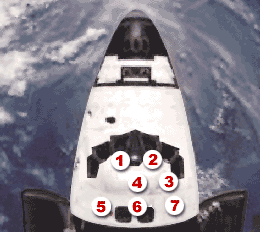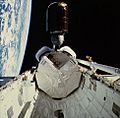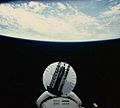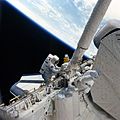STS-51-D facts for kids
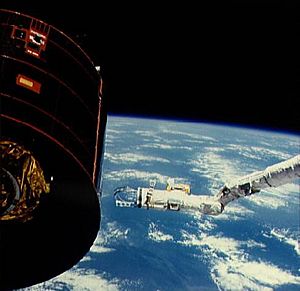
The crew attempt to activate Syncom IV-3 via a "flyswatter" device attached to Discovery's Canadarm
|
|
| Names | Space Transportation System-16 |
|---|---|
| Mission type | Communications satellite deployment |
| Operator | NASA |
| Mission duration | 6 days, 23 hours, 55 minutes, 23 seconds (achieved) |
| Distance travelled | 4,650,658 km (2,889,785 mi) |
| Orbits completed | 110 |
| Spacecraft properties | |
| Spacecraft | Space Shuttle Discovery |
| Launch mass | 113,802 kg (250,890 lb) |
| Landing mass | 89,818 kg (198,015 lb) |
| Payload mass | 13,039 kg (28,746 lb) |
| Crew | |
| Crew size | 7 |
| Members |
|
| EVAs | 1 |
| EVA duration | 3 hours, 6 minutes |
| Start of mission | |
| Launch date | 12 April 1985, 13:59:05 UTC |
| Rocket | Space Shuttle Discovery |
| Launch site | Kennedy Space Center, LC-39A |
| Contractor | Rockwell International |
| End of mission | |
| Landing date | 19 April 1985, 13:54:28 UTC |
| Landing site | Kennedy Space Center, SLF Runway 33 |
| Orbital parameters | |
| Reference system | Geocentric orbit |
| Regime | Low Earth orbit |
| Perigee | 300 km (190 mi) |
| Apogee | 452 km (281 mi) |
| Inclination | 28.45° |
| Period | 94.40 minutes |
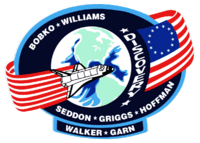 STS 51-D mission patch 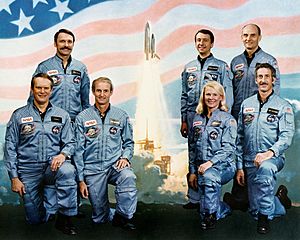 Back row: S. David Griggs, Charles D. Walker, Jake Garn Front row: Karol J. Bobko, Donald E. Williams, Margaret Rhea Seddon, Jeffrey A. Hoffman |
|
STS-51-D was the 16th space mission of NASA's Space Shuttle program. It was the fourth flight for the Space Shuttle Discovery. The mission launched from Kennedy Space Center (KSC) in Florida on April 12, 1985.
The launch was delayed by 55 minutes. This happened because a boat entered a restricted area. After a week in space, Discovery landed back at KSC on April 19, 1985. The shuttle had some problems during landing. Its brakes were badly damaged, and a tire burst. Because of this, future shuttle landings were moved to Edwards Air Force Base in California. They stayed there until new steering technology made KSC landings safer.
Contents
Meet the STS-51-D Crew
| Position | Astronaut | |
|---|---|---|
| Commander | Karol J. Bobko Second spaceflight |
|
| Pilot | Donald E. Williams First spaceflight |
|
| Mission Specialist 1 | Margaret Rhea Seddon First spaceflight |
|
| Mission Specialist 2 | S. David Griggs Only spaceflight |
|
| Mission Specialist 3 | Jeffrey A. Hoffman First spaceflight |
|
| Payload Specialist 1 | Charles D. Walker Second spaceflight |
|
| Payload Specialist 2 | Jake Garn (U.S. Senator R-UT) Only spaceflight |
|
| Garn was a Republican Senator from Utah. He flew as a special observer. He was the first sitting member of Congress to go to space. | ||
Spacewalk Details
Astronauts Jeffrey A. Hoffman and S. David Griggs performed a spacewalk.
- Who: Hoffman and Griggs
- When: April 16, 1985
- Duration: 3 hours, 6 minutes
Crew Seating in Space
The astronauts had specific seats for launch and landing.
| Seat | Launch | Landing | |
|---|---|---|---|
| S1 | Bobko | Bobko | |
| S2 | Williams | Williams | |
| S3 | Seddon | Hoffman | |
| S4 | Griggs | Griggs | |
| S5 | Hoffman | Seddon | |
| S6 | Walker | Walker | |
| S7 | Garn | Garn |
Mission Highlights
During the STS-51-D mission, the crew launched two communications satellites. These were Telesat-I (also called Anik C1) and Syncom IV-3 (also known as Leasat-3). Both satellites were built by Hughes.
Telesat-I was successfully launched. It used a special motor called a Payload Assist Module (PAM-D). However, Syncom IV-3 had problems. Its antenna did not open, and its engine did not start.
The mission was extended by two days to try and fix the satellite. Astronauts Griggs and Hoffman went on an unplanned spacewalk (EVA). They attached special "Flyswatter" tools to the shuttle's robotic arm, the Canadarm. Astronaut Seddon then used the robotic arm to try and activate the satellite. But the satellite still did not work. Later that year, the satellite was brought back to Earth, fixed, and successfully launched again on the STS-51-I mission.
Discovery also carried other experiments. These included a system for separating biological materials (CFES-III). There were also two student experiments and a heart monitoring device (AFE). Other items included "Getaway specials" (small experiments) and tests on how liquids mix in space. The crew also studied how simple toys behave in microgravity (weightlessness). The results of the "Toys in Space" study were shared with school students.
Wake-up Calls from Space
NASA started a fun tradition of playing music to astronauts. This began during the Project Gemini missions. The first time music was used to wake up a crew was during Apollo 15. Each song is chosen carefully, often by the astronauts' families. The music usually has a special meaning to an astronaut or relates to their daily tasks.
| Flight Day | Song | Artist/Composer |
|---|---|---|
| Day 2 | "Top of the World" | The Carpenters |
| Day 3 | "Rescue Aid Society" | Song from the Disney film, The Rescuers |
Images for kids
See also
 In Spanish: STS-51-D para niños
In Spanish: STS-51-D para niños


